Research on Finite Element Model Modification of Carbon Fiber Reinforced Plastic (CFRP) Laminated Structures Based on Correlation Analysis and an Approximate Model
Abstract
:1. Introduction
2. Theoretical Basis for Model Modification Based on Correlation Analysis and Approximate Model
2.1. Model Modification Theory
2.2. Correlation Analysis
2.3. Approximate Model
2.4. Modification Process
- All 10 material parameters of a CFRP laminated structure are collected through an orthogonal test. The collected data groups are calculated by the finite element method, and the response of the sampling points are obtained. Subsequently, the first material parameters which make the most contributions to changes of inherent frequency are screened by Pearson correlation analysis of all sampling points. These parameters are regarded as model modification parameters.
- Based on the above six selected material parameters, a new sample space is constructed and the data points needed to construct the approximate model are collected by the optimal Latin square method. Responses of each sampling point are gained through the finite element method. The approximate model is fitted based on the sampling point data and the corresponding responses and model accuracy are tested.
- The constructed RSM is applied to optimization. The objective function is established between the error between test results and the finite element calculation results of the first four orders of inherent frequency. This objective function is solved by a global searching algorithm (MIGA) and the optimal solution is obtained.
- The optimized material properties are substituted into the finite element calculation, and the error between the finite element calculation results and the test results of inherent frequency are evaluated after optimization of material parameters. The prediction results of the fifth-order and sixth-order inherent frequencies without modification are analyzed to verify the validity of the model modification.
3. Modal Test and Finite Element Analysis
3.1. Modal Test
3.2. Finite Element Calculation
3.3. Frequency Contrast Analysis
4. Model Modification
4.1. Pearson Correlation Analysis
4.2. Approximate Model
4.3. Updating of Models
4.4. Verification of Validity
5. Conclusions
Author Contributions
Funding
Conflicts of Interest
References
- Jin, P.; Zhong, X.; Yang, J.; Sun, Z. Blending design of composite panels with lamination parameters. Aeronaut. J. 2016, 120, 1710–1725. [Google Scholar] [CrossRef]
- Awad, Z.K.; Aravinthan, T.; Zhuge, Y.; Gonzalez, F. A review of optimization techniques used in the design of fibre composite structures for civil engineering applications. Mater. Design 2012, 33, 534–544. [Google Scholar] [CrossRef] [Green Version]
- Wu, C.; Gao, Y.; Fang, J.; Li, Q. Discrete topology optimization of ply orientation for a carbon fiber reinforced plastic (CFRP) laminate vehicle door. Mater. Design 2017, 128, 9–19. [Google Scholar] [CrossRef]
- Ghiasi, H.; Pasini, D.; Lessard, L. Optimum stacking sequence design of composite materials Part I: Constant stiffness design. Compos. Struct. 2009, 90, 1–11. [Google Scholar] [CrossRef]
- Cardoso, J.B.; Valido, A.J. Cross-section optimal design of composite laminated thin-walled beams. Comput. Struct. 2011, 89, 1069–1076. [Google Scholar] [CrossRef]
- Le-Manh, T.; Lee, J. Stacking sequence optimization for maximum strengths of laminated composite plates using genetic algorithm and isogeometric analysis. Compos. Struct. 2014, 116, 357–363. [Google Scholar] [CrossRef]
- Kalantari, M.; Dong, C.; Davies, I.J. Effect of matrix voids, fibre misalignment and thickness variation on multi-objective robust optimization of carbon/glass fibre-reinforced hybrid composites under flexural loading. Compos. Part. B-Eng. 2017, 123, 136–147. [Google Scholar] [CrossRef]
- Sehgal, S.; Kumar, H. Structural Dynamic Model Updating Techniques: A State of the Art Review. Arch. Comput. Methods E 2015, 23, 1–19. [Google Scholar] [CrossRef]
- Lim, J.H.; Hwang, D.S.; Sohn, D.; Kim, J.G. Improving the reliability of the frequency response function through semi-direct finite element model updating. Aerosp. Sci. Technol. 2016, 54, 59–71. [Google Scholar] [CrossRef]
- Modak, S.V. Direct Matrix Updating of Vibroacoustic Finite Element Models Using Modal Test Data. AIAA J. 2014, 52, 1386–1392. [Google Scholar] [CrossRef]
- Halevi, Y.; Bucher, I. Model updating via weighted reference basis with connectivity constraints. J. Sound Vib. 2003, 265, 561–581. [Google Scholar] [CrossRef]
- Savadkoohi, A.T.; Molinari, M.; Bursi, O.S.; Friswell, M.L. Finite Element Model Updating of a Semi-Rigid Moment Resisting Structure. Struct. Control Health Monit. 2015, 18, 149–168. [Google Scholar] [CrossRef]
- Liu, T.; Zhang, Q.; Zordan, T.; Briseghella, B. Finite Element Model Updating of Canonica Bridge Using Experimental Modal Data and Genetic Algorithm. Struct. Eng. Int. 2016, 26, 27–36. [Google Scholar] [CrossRef]
- Wang, X.; Hill, T.L.; Neild, S.A.; Shaw, A.D.; Haddad Khodaparast, H.; Friswell, M.I. Model updating strategy for structures with localised nonlinearities using frequency response measurements. Mech. Syst. Signal Process. 2018, 100, 940–961. [Google Scholar] [CrossRef] [Green Version]
- Sun, W.Q.; Cheng, W. Finite element model updating of honeycomb sandwich plates using a response surface model and global optimization technique. Struct. Multidiscip. Optim. 2017, 55, 121–139. [Google Scholar] [CrossRef]
- Adel, F.; Shokrollahi, S.; Jamal-Omidi, M.; Ahmadian, H. A model updating method for hybrid composite/aluminum bolted joints using modal test data. J. Sound Vib. 2017, 396, 172–185. [Google Scholar] [CrossRef]
- Min, C.H.; Hong, S.; Park, S.Y.; Park, D.C. Sensitivity-based finite element model updating with natural frequencies and zero frequencies for damped beam structures. Int. J. Nav. Arch. Ocean. 2014, 6, 904–921. [Google Scholar] [CrossRef] [Green Version]
- Hernandez-Vazquez, J.M.; Garitaonandia, I.; Fernandes, M.H.; Munoa, J.; de Lacalle, L.N.L. A Consistent Procedure Using Response Surface Methodology to Identify Stiffness Properties of Connections in Machine Tools. Materials 2018, 11, 1220. [Google Scholar] [Green Version]
- Huang, Y.H.; Chen, L.C.; Chou, H.M. Optimization of Process Parameters for Anti-Glare Spray Coating by Pressure-Feed Type Automatic Air Spray Gun Using Response Surface Methodology. Materials 2019, 12, 751. [Google Scholar] [CrossRef]
- Babovic, V.; Sannasiraj, S.A.; Chan, E.S. Error correction of a predictive ocean wave model using local model approximation. J. Mar. Syst. 2005, 53, 1–17. [Google Scholar] [CrossRef]
- Lin, R.M.; Lim, M.K. Analytical model updating and model reduction. AIAA J. 1996, 34, 1966–1969. [Google Scholar] [CrossRef]
- Chakraborty, S.; Sen, A. Adaptive response surface based efficient finite element model updating. Finite Elem. Anal. Des. 2014, 80, 33–40. [Google Scholar] [CrossRef]
- Yang, L.; Wang, L.; Gao, J.; Guo, S.; Ye, X.; Koppala, S.; Hu, T.; Hou, M.; Hu, L. Optimization of Process Parameters for Preparing Metallic Matrix Diamond Tool Bits by Microwave Pressureless Sintering Using Response Surface Methodology. Materials 2018, 11, 2185. [Google Scholar] [CrossRef]
- Boaretti, C.; Roso, C.; Lorenzetti, A.; Modesi, M. Synthesis and process optimization of electrospun, peek-sulfonated nanofibers by response surface methodology. Materials 2015, 8, 4096–4117. [Google Scholar] [CrossRef]
- Wang, W.; Cheng, Y.; Tan, G. Design Optimization of SBS-Modified Asphalt Mixture Reinforced with Eco-Friendly Basalt Fiber Based on Response Surface Methodology. Materials 2018, 11, 1311. [Google Scholar] [CrossRef]
- Zhao, N.; Li, Z. Experiment and artificial neural network prediction of thermal conductivity and viscosity for alumina-water nanofluids. Materials 2017, 10, 552. [Google Scholar] [CrossRef]
- Zhang, W.; Bao, Z.M.; Jiang, S.; He, J.J. An artificial neural network-based algorithm for evaluation of fatigue crack propagation considering nonlinear damage accumulation. Materials 2016, 9, 483. [Google Scholar] [CrossRef]
- Djavanroodi, F.; Omranpour, B.; Sedighi, M. Artificial neural network modeling of ECAP process. Mater. Manuf. Process. 2013, 28, 276–281. [Google Scholar] [CrossRef]
- Aleksendrić, D.; Bellini, C.; Carlone, P.; Ćirović, V.; Rubino, F.; Sorrentino, L. Neural-fuzzy optimization of thick composites curing process. Mater. Manuf. Process. 2019, 34, 262–273. [Google Scholar] [CrossRef]
- Mottershead, J.E.; Friswell, M.I. Model updating in structural dynamics: A survey. J. Sound Vib. 1993, 167, 347–375. [Google Scholar] [CrossRef]
- Kirwan, J.R. Reporting of significance levels versus Pearson’s correlation coefficient. Rheumatology 1984, 23, 232–233. [Google Scholar] [CrossRef]
- Levin, R.I.; Lieven, N.A.J. Dynamic finite element model updating using neural networks. J. Sound Vib. 1998, 210, 593–607. [Google Scholar] [CrossRef]

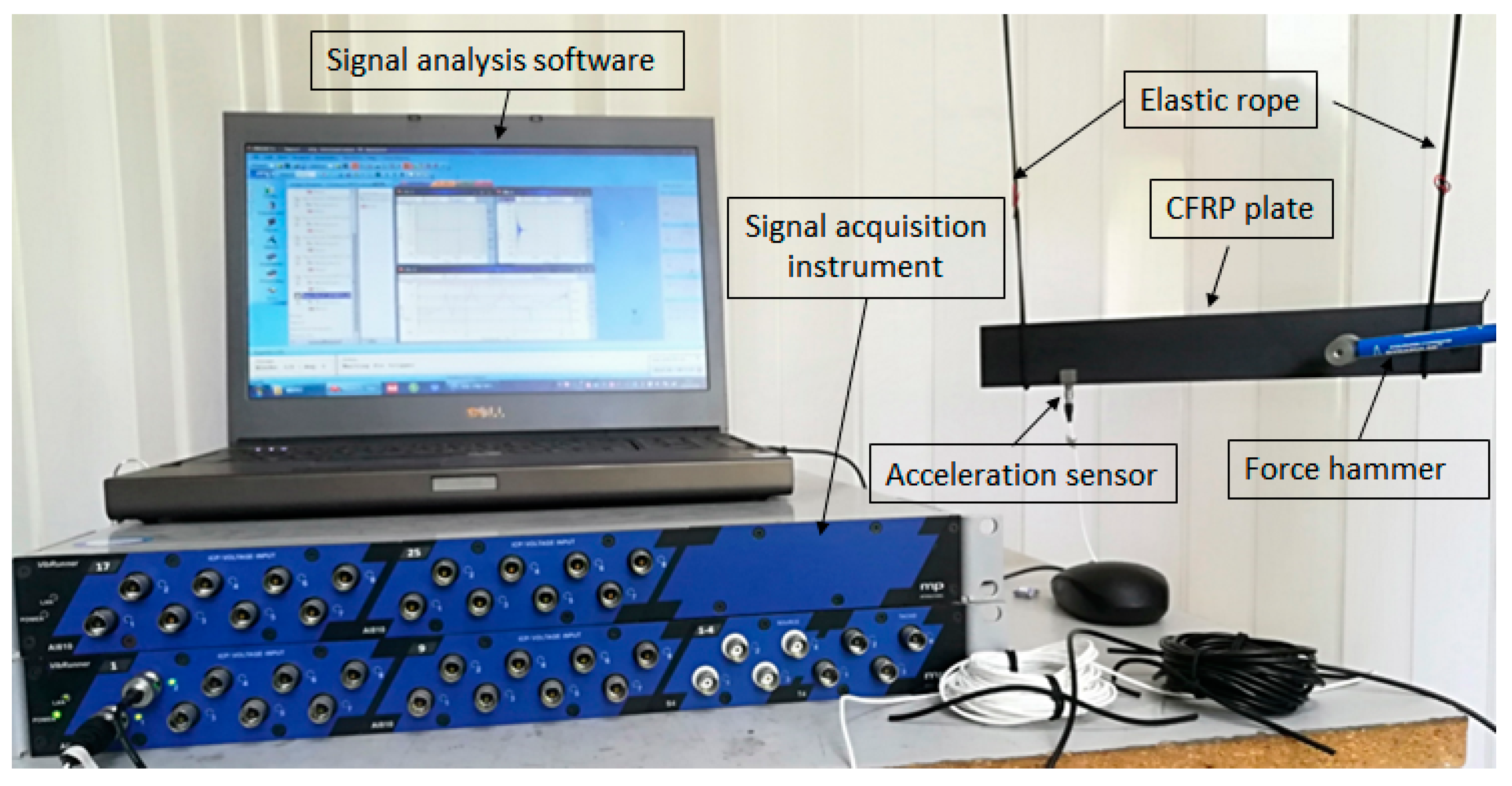


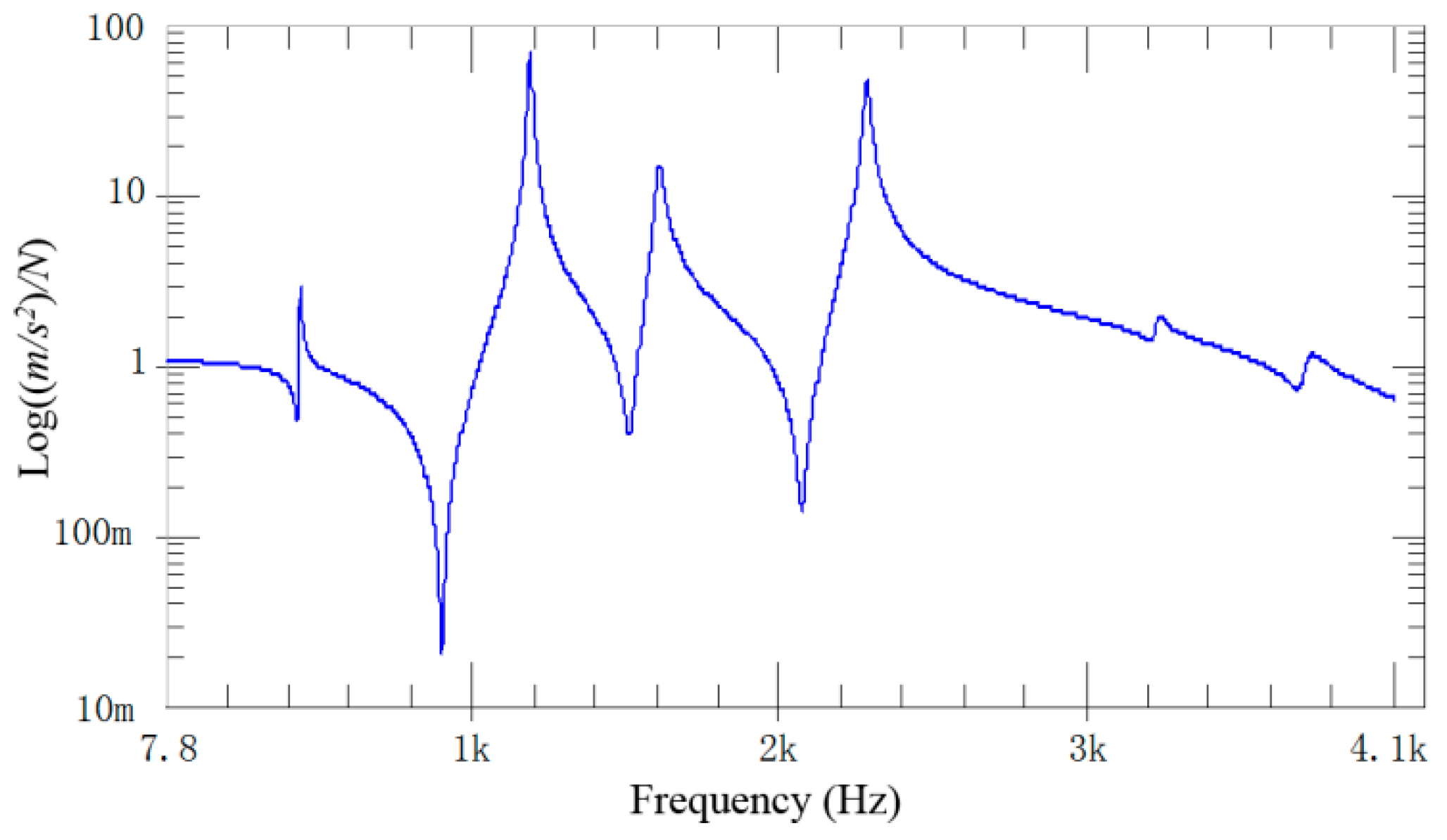
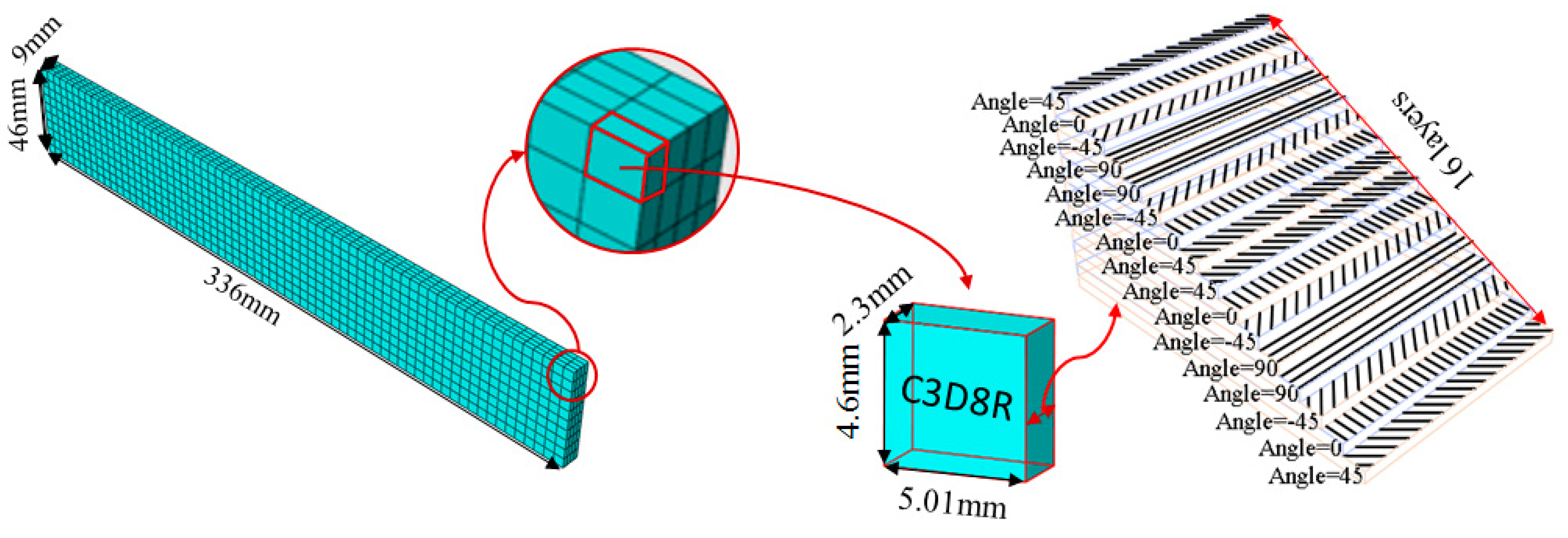
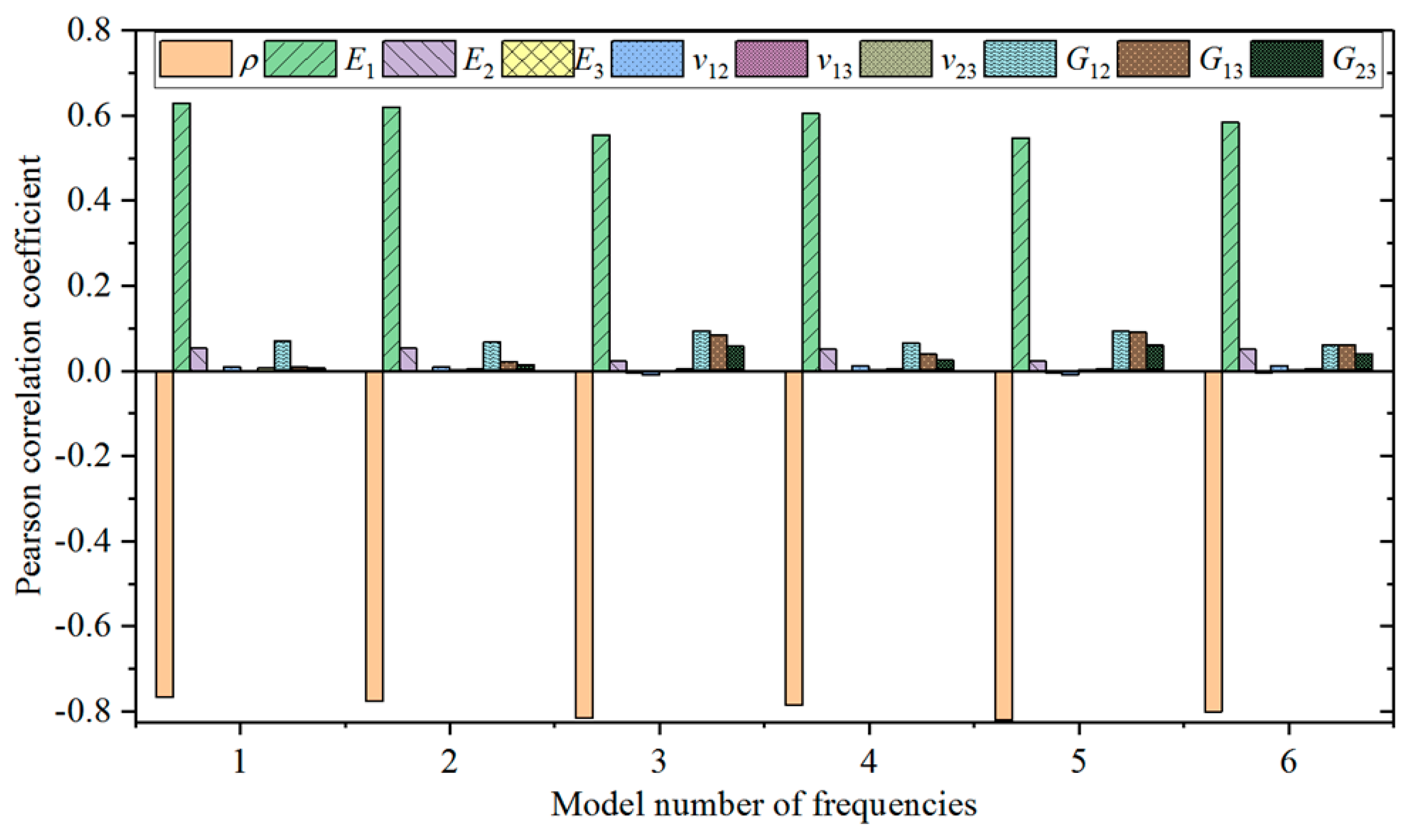
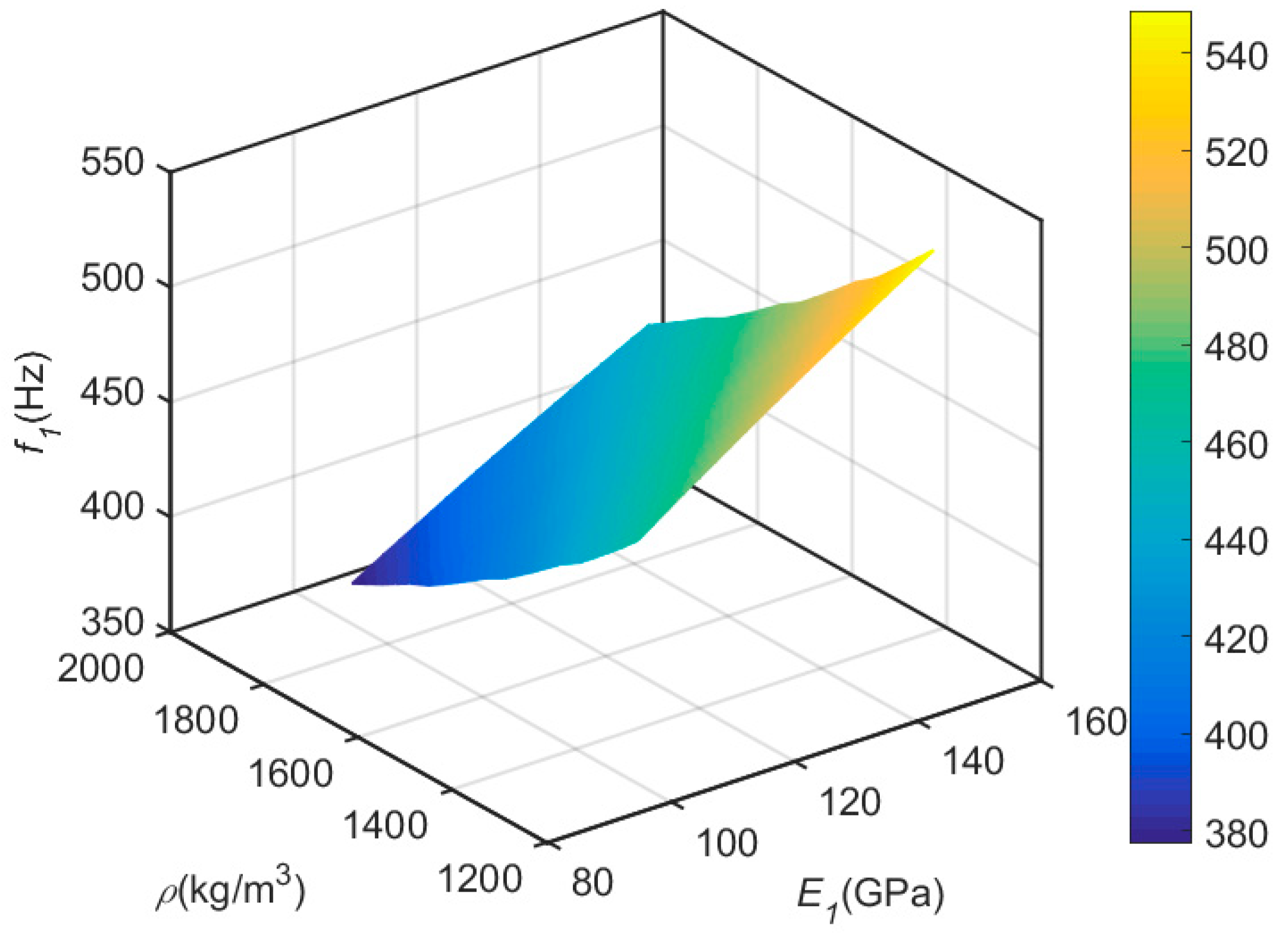
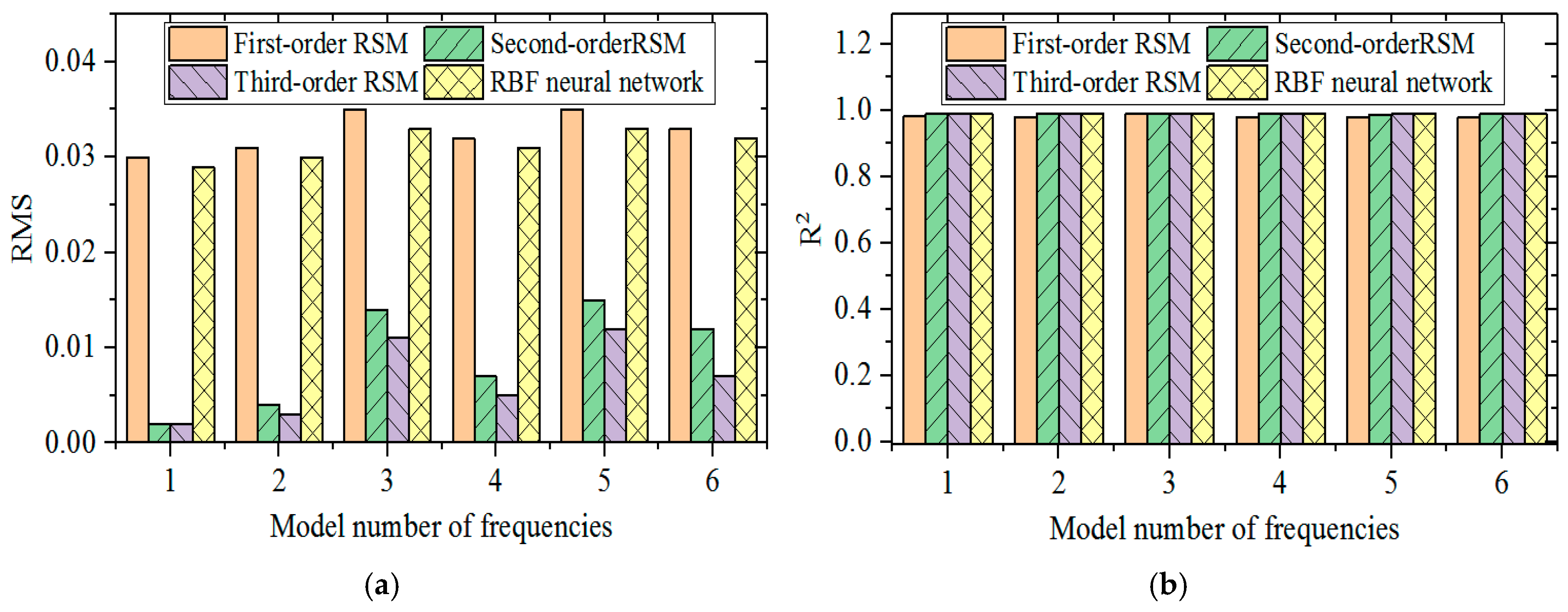

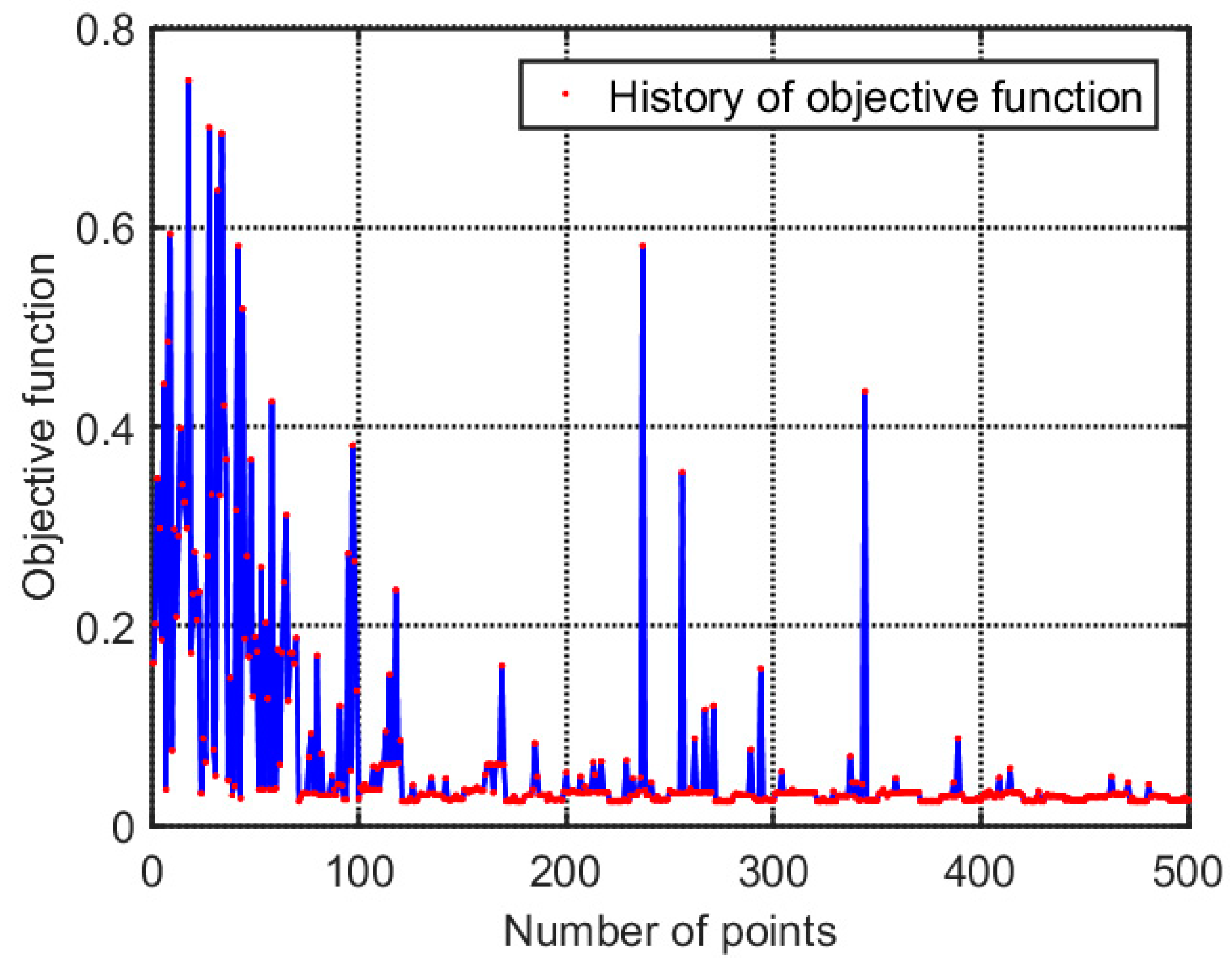

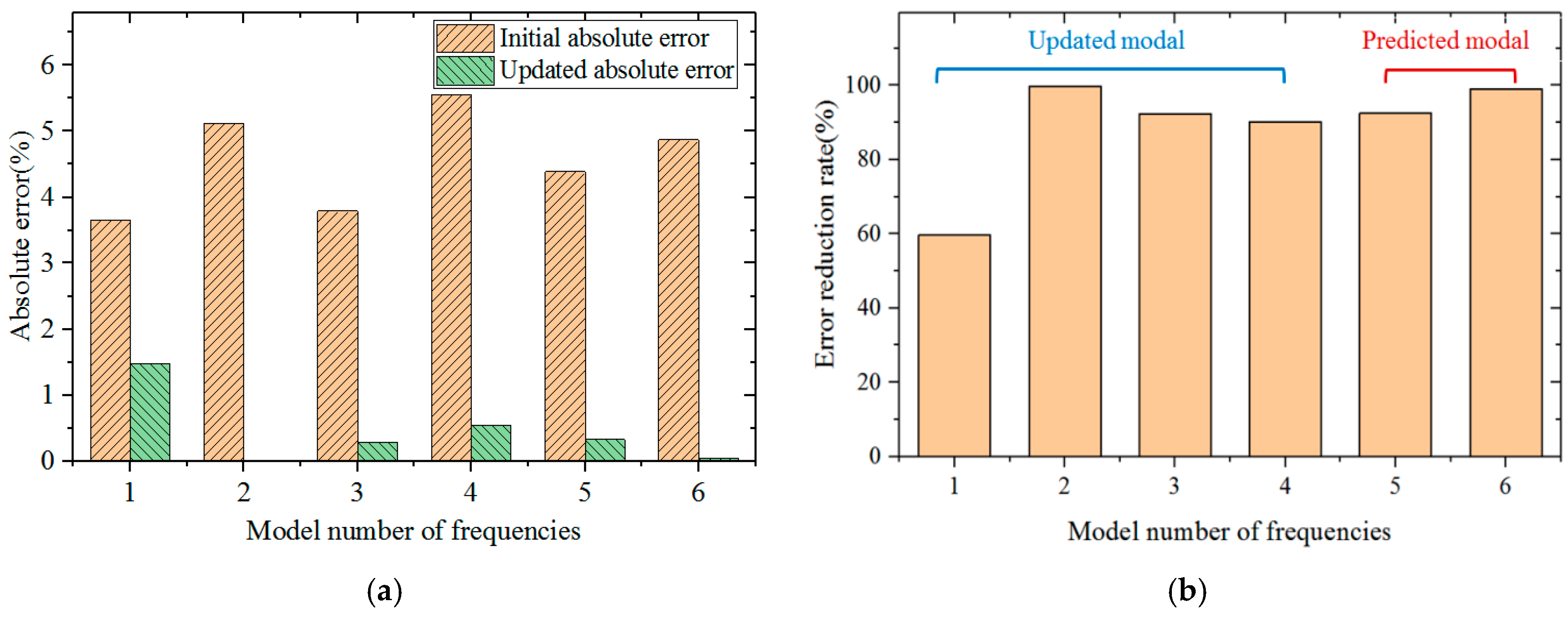
| Name | Type |
|---|---|
| Signal acquisition instrument | m + p vib runner VR3 |
| Signal analysis software | m + p SO Analyzer |
| Fore hammer | DYTRAN 5800B4 (sensitivity: 2.25 mv/N |
| Acceleration sensor | DYTRAN 3097A2 (sensitivity: 98.36 mv/g) |
| E1(GPa) | E2 ≈ E2(GPa) | G12 ≈ G13(GPa) | G23 (GPa) | v12 ≈ v13 | v23 | ρ(kg/m−3) |
|---|---|---|---|---|---|---|
| 120 | 10.5 | 5.25 | 3.48 | 0.3 | 0.45 | 1520 |
| Mode Shape from Test | Mode Shape from FE | Description | |
|---|---|---|---|
| Mode 1 | 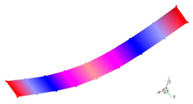 |  | The first bending mode (Bending along y-axis) |
| Mode 2 |  |  | The second bending mode (Bending along y-axis) |
| Mode 3 | 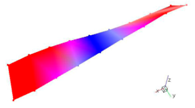 |  | The first torsion mode (Translation along x-axis) |
| Mode 4 | 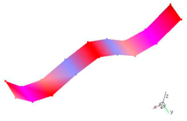 |  | The third bending mode (Bending along y-axis) |
| Mode 5 |  |  | The second torsion mode (Translation along x-axis) |
| Mode 6 | 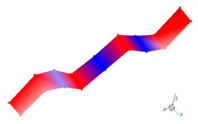 |  | The forth bending mode (Bending along y-axis) |
| Mode | Test Frequency (Hz) | Initial FE Model Frequency (Hz) | Absolute Error (%) |
|---|---|---|---|
| 1 | 445.43 | 461.70 | 3.65 |
| 2 | 1194.56 | 1255.7 | 5.12 |
| 3 | 1619.75 | 1681.1 | 3.79 |
| 4 | 2286.33 | 2413.4 | 5.56 |
| 5 | 3235.93 | 3377.9 | 4.39 |
| 6 | 3707.16 | 3887.5 | 4.87 |
| Average value | - | - | 4.56 |
| Technical Parameters | Value |
|---|---|
| Sub-population size | 5 |
| Number of islands | 5 |
| Number of generations | 10 |
| Rate of crossover | 1 |
| Rate of mutation | 0.01 |
| Rate of migration | 0.01 |
| Interval of migration | 5 |
| Parameter | ρ (kg/m−3) | E1 (GPa) | E2 (GPa) | G12 (GPa) | G13 (GPa) | G23 (GPa) |
|---|---|---|---|---|---|---|
| Initial value | 1520 | 120 | 10.5 | 5.25 | 5.25 | 3.48 |
| Final value | 1684 | 118.11 | 10.01 | 6.21 | 6.22 | 3.23 |
| Mode | Test Frequency (Hz) | Updated Frequency (Hz) | Absolute Error (%) |
|---|---|---|---|
| 1 | 445.43 | 438.87 | 1.47 |
| 2 | 1194.56 | 1194.7 | 0.01 |
| 3 | 1619.75 | 1615.1 | 0.29 |
| 4 | 2286.33 | 2298.9 | 0.55 |
| 5 | 3235.93 | 3246.5 | 0.33 |
| 6 | 3707.16 | 3709.1 | 0.05 |
| Average value | - | - | 0.45 |
© 2019 by the authors. Licensee MDPI, Basel, Switzerland. This article is an open access article distributed under the terms and conditions of the Creative Commons Attribution (CC BY) license (http://creativecommons.org/licenses/by/4.0/).
Share and Cite
Zhang, Y.; Yang, Y.; Du, W.; Han, Q. Research on Finite Element Model Modification of Carbon Fiber Reinforced Plastic (CFRP) Laminated Structures Based on Correlation Analysis and an Approximate Model. Materials 2019, 12, 2623. https://doi.org/10.3390/ma12162623
Zhang Y, Yang Y, Du W, Han Q. Research on Finite Element Model Modification of Carbon Fiber Reinforced Plastic (CFRP) Laminated Structures Based on Correlation Analysis and an Approximate Model. Materials. 2019; 12(16):2623. https://doi.org/10.3390/ma12162623
Chicago/Turabian StyleZhang, Yizheng, Yu’e Yang, Wenhao Du, and Qing Han. 2019. "Research on Finite Element Model Modification of Carbon Fiber Reinforced Plastic (CFRP) Laminated Structures Based on Correlation Analysis and an Approximate Model" Materials 12, no. 16: 2623. https://doi.org/10.3390/ma12162623




